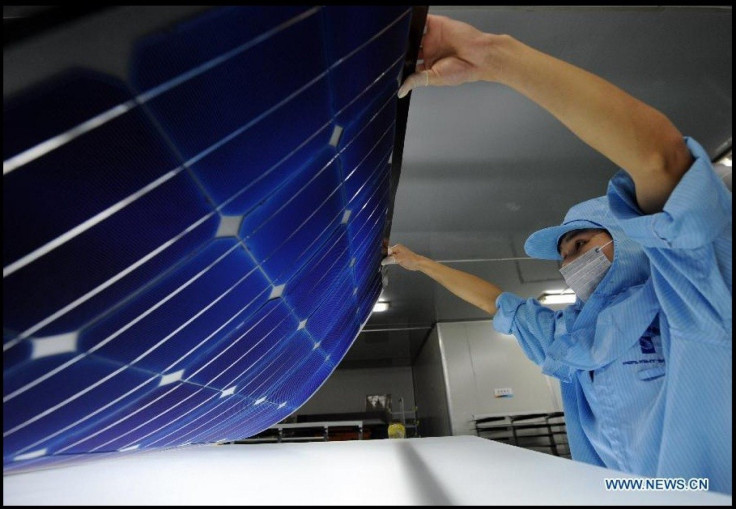China Invests Heavily In Clean Energy - But Is It Too Little, Too Late?

How much will it cost to turn back the clock on China's ecological destruction? After years of promoting fast-paced, state-led economic growth, which has disproportionately benefited the country's massive steel, coal, and oil companies, the government is now moving to spend more on cutting emissions and supporting renewable energy.
China's Ministry of Finance said last week that the central government will spend 170 billion yuan, or almost $27 billion, this year on improving energy efficiency and building renewable-energy infrastructure. For comparison, that means the government will spend in just one year half of the entire sum spent over five years, between 2007 and 2012, on improving energy efficiency.
Those figures are certainly sizable, but billions more will be needed.
The State Environmental Protection Agency said that pollution cost the national economy more than $200 billion in one year -- and that was in 2006. China is now the world's top emitter of carbon dioxide, ahead of the U.S., which it surpassed in 2007. The country also passed the U.S. to become the world's greatest energy consumer in 2009. In 2010 it overtook Japan to become the world's second-largest economy.
But that also means China is a very inefficient energy user, consuming more energy and making more pollution to generate a unit of GDP compared to either the U.S. or Japan.
During the past 20 years, most of the country's astonishing growth and its new factories and cities have been fed by coal power, dirtying the water and air. Coal accounted for roughly 75 percent of all of China's energy production in 2011. Hydroelectric power and nuclear energy provided 6 and 1 percent respectively, with wind and solar energy contributing neglible amounts. The government now plans for renewable sources to provide more than 10 percent of total energy by 2016, but it remains unspecificed how much wind and solar will really be able to contribute to that figure.
The U.S. Energy Information Administration, a division of the Department of Energy, expects China to consume 110.7 quadrillion Btus of total energy in 2012. That is more than four times the estimate for India; more than 5 times the estimate for Japan; and ahead of the U.S.' own massive 99.5 quadrillion Btus. The EIA also estimates that China will produce 8,598 million metric tons of carbon dioxide in 2012, more than the U.S., Japan, and India combined.
China's government expects to spend that infusion of money in the later part of this year and next year on promoting green technologies and the expanded use of solar energy -- a major challenge. Although China makes roughly 30 percent of the world's solar cells, most are for export; few remain in the country to be used by average citizens, due to high cost. The country is the world's biggest user of solar water heaters, but families don't really have the option of buying their own solar roof, installing it on their house, and then contributing excess power back to the grid, as in the U.S. Although China had the world's largest installed wind generating capacity by 2010, critics said that much of it was unlinked to the actual grid. The current report from the Finance Ministry made no specific mention of wind energy.
The government will also gear towards producing more energy-efficient technologies. It plans to support green industries by developing electric cars and adopting hybrid buses in large and medium-sized cities. However, $27 billion will obviously not be enough to subsidize the purchases of hybrid autos by private citizens. The country launched a pilot study for the subsidizing of green automobiles in 2010 in Shanghai, but the initiative only covered all-electric vehicles.
There are however, some bright notes in this otherwise uninspiring picture. The International Energy Agency says that between 2005 and 2011, China's carbon intensity fell by 15 percent. That means less pollution is being made for every unit of GDP added.
By 2020, China plans to cut greenhouse gas emissions by as much as 45 percent of its 2003 levels. By then, it hopes that renewable energy will account for 15 percent of total energy consumption.
One of the more innovative approaches to the pollution problem in China involves very little new infrastructure. A pilot study for carbon quotas and trading is being set up in China, including components of a plan for establishing an environmental tax, or carbon tax, policy. That could drastically change the way factories and power plants operate, using the market to move funds to punish polluters and reward clean businesses. The government plans to establish a nationwide system by 2015-2016, although many are skeptical. Reuters' Point Carbon, a CO2 and energy analytics shop, says meeting the deadline is unlikely. The Stockholm Energy Institute and the Forum for Reforms, Entrepreneurship and Sustainability, both think tanks, doubt whether a carbon trading scheme could really be effective in a country without a true free-market economy.
© Copyright IBTimes 2024. All rights reserved.





















